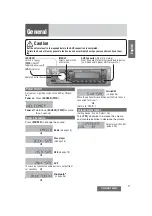
Non-Sound Decoder MX600 - MX634 and Sound Decoder MX640 - MX658 Page 23
“Distance controlled stopping“, when activated, is
exclusively
applied
to decelerations leading to a
full stop,
but not to speed reductions without stopping (these are still handled by CV #4). Neither is
there any influence to acceleration events.
The traveled distance is constantly being recalculated in order to get as close as possible to the de-
sired stop point. The deceleration rate within distance controlled stopping is always applied exponen-
tially, that is the deceleration rate is high in the top speed range followed by gentle braking until the
train comes to a full stop; which in this case is
not
governed by CV #122! The application of CV #121
for exponential acceleration however remains unchanged.
3.13 Shunting, Half-Speed and MAN Functions:
On the one hand, defining the different Configuration Variables (#3, 4, 121, 122 and 123) offers proto-
typical acceleration and deceleration behavior, but is on the other hand often obstructive for quick and
easy shunting.
This is why the momentum can temporarily be reduced or eliminated altogether with a dedicated func-
tion key. Also, during shunting maneuvers it is sometimes helpful to have the speed range of the
throttle cut in half.
For historical reasons, the assignments for these "shunting-key functions" are summarized in CV
#124, which is associated with restrictions and also relatively confusing.
From today’s perspective,
CV's #155, #156 and #157 are the
preferred
CV’s for these settings,
where function keys can be selected in a systematic and unlimited manner for each of the shunting
and MAN functions. CV #124 (Bits 0 & 1) is still relevant though for the type of momentum deactiva-
tion.
#124
Shunting key
functions:
Low gear (half speed)
and
Momentum reduction
or deactivation
NOTE:
Extended shunting key
selection in
CV’s #155, 156
Bit 5
DC stopping
Bit 7
Changing SUSI pins to
logic level outputs
Bits
0 - 4, 6
0
Select a function key for
LOW GEAR ACTIVATION:
Bit 4 = 1 (and Bit 3 = 0): F3 as half-speed key
Bit 3 = 1 (and Bit 4 = 0): F7 as half-speed key
Select a function key for
MOMENTUM DEACTIVATION:
Bit 2 = 0 (and Bit 6 = 0): “MN” key for deactivation,
Bit 2 = 1 (and Bit 6 = 0): F4 key for deactivation
Bit 6 = 1 (Bit 2 is irrelevant): F3 for deactivation.
Effect of above key (MN, F3 or F4) on
MOMENTUM:
Bit 1, 0 = 00: no effect on momentum
= 01: removes momentum of
CV #121 + #122
= 10: CV #3 + #4 reduced to ¼.
= 11: removes all momentum above.
EXAMPLES:
F3 for half speed-key: CV #124 = 16.
F3 for half speed-key and F4 to remove momentum
completely: Bits 0, 1, 2 & 4 = 1; that is CV #124 =23.
F3 for half-speed key and removing momentum:
Bits 0, 1, 4 &6 = 1; that is CV #124 = 83.
Bit 5 = 1:
”DC stopping“
Bit 7 = 0:
SUSI-interface active
= 1
: FU-outputs active instead of SUSI
.
#155
Selecting a function key
as half-speed key
0 - 19
0
Expanding on the settings of CV #124; if another key is
required than F3 or F7:
CV #155: Defines a function key for half-speed activa-
tion (= top speed cut in half).
If a key is assigned with CV #155, a possible assign-
ment through CV #124 is disabled.
CV
#155 = 0 doesn’t mean that the F0 key is assigned
but rather that the setting in CV #124 is active.
#156
Selecting a function key
for deactivating
momentum
0 - 19
0
Expanding on the settings of CV #124; if another key
than F3, F4 or MAN is required for momentum deactiva-
tion:
CV #156: Defines the function key that deactivates or
reduces the acceleration and decelera
tion times in CV’s
#3, 4, 121 and 122.
After defining a key with this CV, the momentum deacti-
vation or reduction still needs to be defined in CV #124:
CV #124, Bit 1, 0:
= 00: no effect on momentum
= 01: removes momentum of
CV #121 + #122
= 10: CV #3 + #4 reduced to ¼.
= 11: removes all momentum.
In order to deactivate all momentum, CV #124 is
typically set to a value of 3 (the total value may be dif-
ferent if other Bits in CV #124 are also set).
A possible key assignment for momentum deactivation
in CV #124 is disabled if CV #156 > 0.
#157
Selecting a function key
for the
MAN function
Only for non-ZIMO
cabs
that don’t have the
dedicated MN key.
0 - 19
0
The MAN function (or MAN key on ZIMO cabs) was
originally designed for ZIMO applications only, in order
to cancel stop and speed limit commands applied by the
signal controlled speed influence system (HLU).
This function was expanded in later software versions to
include “asymmetrical DCC signal stops” (Lenz ABC).
If ZIMO decoders are used with non-ZIMO systems that
don’t have this key, a function key can now be assigned
with CV #157 to cancel a signal controlled speed limit or
stop command.
















































